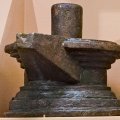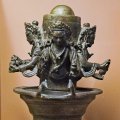Patan Museum (Nepal): photo 161
Photo 161 of 212 in Gallery: Patan Museum (Nepal)

Image title: Halo with Linga (Nepal, 15th century)
Description of the photo
(Top)
This Copper sculpture shows a Halo with Linga, from the 15th/16th century origination from Nepal.—Materials used: Copper repoussé, gilt.
Description: This halo was meant to provide a “Circle of Light” (prabhamandala) around an image, now missing. The lotus-supported Shivalinga at the top resembles the ancient linga on the left side of this case. A pair of Kinnaras. half-bird, half-human, standing on lotus blossoms gesture in homage toward the missing deity.
(Bottom)
A Bronze sculpture showing a Four-faced Shivalinga Shrine, from the 17th/18th century origination from Nepal.—Materials used: Bronze.
Description: A four-faced linga rests on a focus emerging from a pool, symbolized by concentric lines. Floating on it arc another lotus and a pair of feet. The feet probably represent Goraksanatha [Gorakhnath], a deified Yogi identified with Shiva. The pool is railed and guarded by the Eight Bhairavas, two at each gateway. Nandi, the bull, crouches in the western one.
Gallery information:
The Patan Museum is located on the Durbar square of Patan (Lalitpur/Lalitapura, Kathmandu, Nepal) which is associated Keshav Narayan Chowk (Keshavnarayan)—a form of Lord Vishnu. Being listed as a World Heritage Site, the whole of Durbar square is filled with exquisite temples, sculptures and other ancient structures, of which the ancient history history can be traced to the Malla Kings of Lalitpur. It is an important site for both Buddhism and Hinduism.
Photo details:
Date: 2019-12-02
Camera: SONY ILCE-6400
Exposure: 1/20
Aperture: f/5
ISO: 100
Focal length: 18mm
High resolution:
Download file
Size: 1.56 MB
Resolution: 1195 x 1742
© Photograph by Gabe Hiemstra.
License: CC BY-NC-ND 4.0

